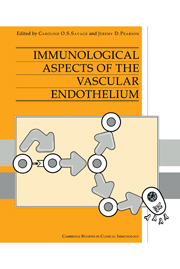Book contents
- Frontmatter
- Contents
- List of contributors
- Preface
- 1 New concepts of mechanisms in autoimmunity
- 2 Regulation of endothelial cell function by cytokines
- 3 Interactions between granulocytes and endothelium
- 4 The regulation of lymphocyte migration by vascular endothelium and its role in the immune response
- 5 Role of the vascular endothelium in immunologically mediated neurological diseases
- 6 The role of the endothelium in systemic lupus erythematosus and Sjögren's syndrome
- 7 The role of the endothelium in rheumatoid arthritis and scleroderma
- 8 The role of the endothelium in systemic vasculitis
- 9 Endothelial involvement in childhood Kawasaki disease
- 10 The role of the endothelium in thrombotic thrombocytopaenic purpura and haemolytic uraemic syndrome
- 11 The immunological role of the endothelium in organ transplantation
- Index
11 - The immunological role of the endothelium in organ transplantation
Published online by Cambridge University Press: 04 August 2010
- Frontmatter
- Contents
- List of contributors
- Preface
- 1 New concepts of mechanisms in autoimmunity
- 2 Regulation of endothelial cell function by cytokines
- 3 Interactions between granulocytes and endothelium
- 4 The regulation of lymphocyte migration by vascular endothelium and its role in the immune response
- 5 Role of the vascular endothelium in immunologically mediated neurological diseases
- 6 The role of the endothelium in systemic lupus erythematosus and Sjögren's syndrome
- 7 The role of the endothelium in rheumatoid arthritis and scleroderma
- 8 The role of the endothelium in systemic vasculitis
- 9 Endothelial involvement in childhood Kawasaki disease
- 10 The role of the endothelium in thrombotic thrombocytopaenic purpura and haemolytic uraemic syndrome
- 11 The immunological role of the endothelium in organ transplantation
- Index
Summary
Vascular endothelial cells form the interface between the tissues and the circulation and are therefore uniquely positioned to participate in inflammatory reactions at sites of antigenic stimulation. In the setting of transplantation the first foreign surface to be encountered by circulating host leukocytes is the endothelial lining of the donor organ. Donor endothelial cells have the capacity to both express antigens which may be recognized as foreign, including major histocompatibility complex molecules, and to present such antigens to host lymphocytes. In addition, endothelial cells are capable of undergoing a number of functional changes, collectively termed ‘activation’ (Pober, 1988; see Chapter 2), which enable them to promote inflammatory reactions. These include the modulation of vascular tone and permeability, the synthesis and expression of surface glycoproteins and soluble factors which promote the local accumulation, activation and subsequent extravasation into the tissues of leukocytes, and alterations in surface molecules which promote intravascular coagulation. Endothelial cells may thus both initiate allogenic immune responses and become active participants in the development of immune inflammatory reactions.
Endothelial cells as initiators of immune inflammation
The initiation of an immune response to foreign antigen generally requires activation of CD4 helper T cells. Activated helper T cells are necessary for the growth and differentiation of B cells into antibody producing plasma cells in the case of humoral immunity, or activation of macrophages and cytolytic T lymphocytes in the effector phase of cell-mediated immune responses.
- Type
- Chapter
- Information
- Immunological Aspects of the Vascular Endothelium , pp. 233 - 252Publisher: Cambridge University PressPrint publication year: 1995
- 1
- Cited by



